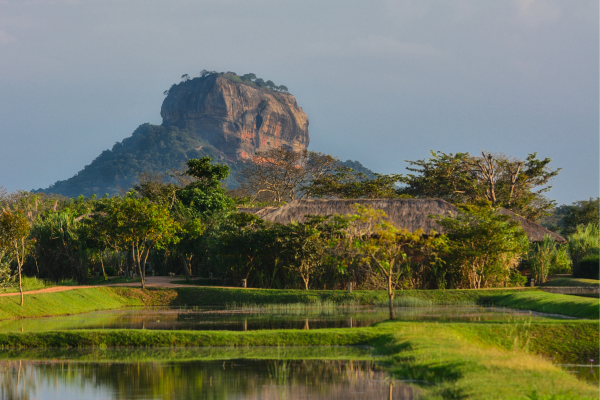The economy During Sigiriya was the Capital of Ceylon. – By Dr Tilak S. Fernando
 Although I managed (the author of the book) to systematically detail different epochs of economic development in ancient Ceylon, it is impossible to forecast, in detail, during the Sigiriya reign. It is because it is impossible to categorise Sigiriya’s economy into various sections. Because the King murdered his father and all his subjects and the Buddhist clergy despising the King had become a political problem.
Although I managed (the author of the book) to systematically detail different epochs of economic development in ancient Ceylon, it is impossible to forecast, in detail, during the Sigiriya reign. It is because it is impossible to categorise Sigiriya’s economy into various sections. Because the King murdered his father and all his subjects and the Buddhist clergy despising the King had become a political problem.
According to old folk stories, King Kasyapa collected wealth. He kept it in protected custody, but later, out of that fortune, he constructed a beautiful chamber out of gold and lived there as emperor Wesamuni. His wealth was considered by all the kings from the Anuradhapura era.
According to folk stories, once he (Kasyapa 1) ordered the killing of all cooks and horse keepers to be killed as his brother Mugalan would conceal his identity. During the Sigiriya epoch, creative designer trade, army, servants, and agriculture, which were vastly popular in the Anuradhapura era, also existed during the Sigiriya period.
Before Sigiriya’s reign commenced following Thammana and Upatissa towns as capitols, it is impossible to fathom that due to the security aspect of Sigiriya as a kingdom was chosen after a long spell from the Anuradhapura era. The argument that could be put forward in this regard was that the Sigiriya reign was the outcome of King Kasyapa 1 after murdering his father.
King’s unpopularity
King Kasyapa 1 became unpopular with his subjects and the Buddhist clergy after he ordered his father’s brutal killing. He was always fearful that his brother Mugalan would confront him at any moment as he gave orders to plaster his father into a brick wall. When he became the King, he instructed to kill all cooks,
Sigiriya, having a social and economic collaboration to bu was necessary. King Kasyapa 1 intended to make Sigiriya a prominent city. According to old folk stories, Sigiriya was found many decades after the Anuradhapura kingdom.
After so many centuries, Sigiriya is well known today. Maybe the King made Sigiriya at the time a hideout for him. However, it was systematically done by building a palace for him with other buildings and water gardens etc. As highlighted in the similar fashion mentioned in the previous episodes (such as in the Anuradhapura era), all of the kings’ income was received out of taxes of his subjects. The King ruled for eighteen years altogether.
Paying Penance
King Kasyapa 1 could have been more pious. One wonders how he managed to rule in the form of Dasaraja Dharmaya fashion (meaning – Charitability, Generosity, Straightforwardness, Humility, Innocence, Peacefulness, Anger, Calmness and Independence). It is debatable how the King became unpopular by giving orders to kill his father.
To forgive the sins for committing his father to be murdered, the King planted in front of his palace around the Sigiriya rock, a few hundred meters apart, parks containing mango trees. He gave instructions to build the Isurumumi Vihara. The King further constructed Buddhist temples and viharas. Although the King could not pardon himself for the murder of his father, it was believed that when his brother Mugalan came to take revenge on him, he may have confronted his brother with all his might. Still, when he was defeated, he cut his own throat to pay for his grave sin of committing to order his father to be plastered to a brick wall.
Frightening Era
The Sigiriya epoch was a frightening social era because people had to serve a king who killed his father. His thoughts were that his bother Mugalan would threaten his life. Prince Mugalan bringing a squad of people from India showed that Ceylon had international connections and that Ceylon earned global respect for Technology and industries during this era. It was because some technology was an excellent skill amongst ancient Ceylonese and still exists to date. The paintings on the rock remain unspoilt. It shows how advanced the Technology had been during Sigiriya’s epoch. The Sigiriya rock is 681 feet high. On top, there are three acres of land where King Kassapa 1 had built a palace and a few more buildings. On top of the rock were around 100 acres of walls recorded with extended drains. These were protected by two gates, one towards the north and one towards the west. A machine from the front Bridge operated a bridge. It shows how advanced was ancient Ceylon technology.
Ruined Equipment
There was some ruined equipment in the Colombo Museum, which belonged to the Sigiriya period. These belonged to the 5th century and were the most modern paraphernalia compared with modern equipment. Among these were agricultural, household and war apparatus. Today England is famous for iron and steel but was founded in 1706, 12 years before the Sigiriya era.
Old Ceylonese skills, particularly water management, have been exposed recently from Sigiriya grounds—water management, which goes back to the 5th century. Water could pump up to 681 up to the peak of the Sigiri rock using pipes made out of clay from a tank built by ancient technologists at the base of the Sigira rock. Archaeologists have unearthed a few furrows where clay earth was found out of which these pipes were made. Sigiri graffiti on ramparts and on top of the rock in the King’s palace, how the water supply was provided to the ponds etc., showed how advanced the Ceylonese old engineers had been.
Courtesy: The writer translated into English from the text of the late Prasad Milinda Siriwardena, Ceylon Economic Analysis between BC 543 to 1832








